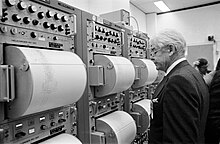Lunar seismology


Lunar seismology is the study of ground motions of the
History
Several
The
Major findings
Moonquakes
Several categories of
Structure of the Lunar Interior
One key finding was an improved understanding of the structure of the deep lunar interior, including the existence of a solid inner-core and sharp core-mantle boundary and a partial-melt layer at the base of the lunar mantle.[9][10][11][12] The solid core has a radius of about 240 km and is surrounded by a much thinner liquid outer core with a thickness of about 90 km.[10] The partial melt layer sits above the liquid outer core and has a thickness of about 150 km. The mantle extends to within 45 ± 5 km of the lunar surface.[12]
Limitations of the current dataset
- Scattering from the megaregolith Strong variations in material properties near the surface of the Moon, likely caused by a long history of impact cratering, are thought to be responsible for the complex seismic waveforms that lack clear reflected arrivals that would provide clear seismological evidence of a lunar core.
- Selenographical distribution All of the Apollo seismometers were placed on the near side of the Moon. The relative dearth of moonquakes observed on the far side of the Moon has been interpreted as either (1) evidence for an attenuating core or (2) observational bias given that it is easier to detect events of a fixed magnitude that are closer to the sensors.
Future plans
This section needs to be updated. (January 2022) |
Due to the success of the Apollo seismometers, several space agencies including NASA have expressed interest in funding future seismic missions to the Moon. NASA's Planetary Science Decadal Survey for 2012-2022 [13] lists a lunar geophysical network as a recommended New Frontiers mission. The mission would be tasked with enhancing the knowledge of the lunar interior using several identical landers distributed over the lunar surface. A network of arrays would be able to better constrain lunar seismicity, especially on the far side of the Moon.
In early 2018, NASA established the Development and Advancement of Lunar Instrumentation (DALI) program.[14] DALI funds research to support the Science Mission Directorate's Planetary Science Division, including the desired lunar geophysical network. NASA awarded five DALI grants in 2024, including research on ground-penetrating radar and a magnometer system for determining properties of the lunar core.[15]
References
- .
- hdl:2060/19790009611.
- ^ Apollo 15 Mission. Lunar and Planetary Institute Retrieved 2012-02-12.
- ^ "ILSA listens to the movements around the landing site". www.isro.gov.in. Archived from the original on 17 September 2023. Retrieved 31 August 2023.
- ^ Cite error: The named reference
naturewas invoked but never defined (see the help page). - .
- .
- .
- .
- ^ S2CID 206530647.
- .
- ^ .
- ISBN 978-0-309-22464-2.
- ^ "NASA Research Announcement: Development and Advancement of Lunar Instrumentation Program". NSPIRES NASA Solicitation and Proposal Integrated Review and Evaluation System. NASA Research and Education Support Service. Retrieved 8 October 2018.
- ^ "NASA Awards Grants for Lunar Instrumentation". NASA. The National Aeronautics and Space Administration. Retrieved 8 April 2024.

